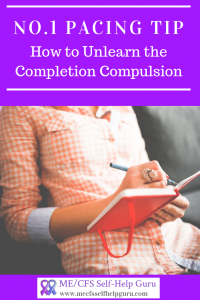This is a post I wrote especially for ProHealth’s Inspirational Corner and first appeared there about 2 months ago.
There is nothing in our once healthy previous lives that can prepare us for what’s involved in getting good at pacing. At least in the way that the very limited energy of illnesses like ME/CFS, Fibromyalgia and Lyme disease demands. Pacing to someone healthy, might mean something like keeping their speed down on a long-distance run, or having a couple of breaks when pulling and all-night study session. It tends to be only for special occasions that demand a long haul of energy expenditure. When you have a chronic illness, pacing is about every day. Day in day out, we aim to be careful with energy so that we can minimise flares and do what we can to get the most out of a now, very restricted life. Unfortunately, taking good care of our energy means unlearning automatic patterns of behaviour that no longer work for us. These behaviours became our automatic program only because they were so successful when we had a healthy body, so unlearning the automatic is hard!
Overcoming the completion compulsion
One thing that will regularly trip us up, is the urge to finish something once we’ve started. It’s such a common obstacle to good pacing I’ve named it the completion compulsion. In a previous healthy life, seeing something through; pushing to get something finished, usually equated to success. Now though it means pushing our cells into a less efficient emergency energy production state than can result in pain and post exertional malaise.
Awareness
The first step to unlearning, is always awareness: we have to be able to notice that the urge to push to complete is happening. Only when we notice it, can we make a different choice. If you’re not noticing it until after you’ve already pushed too far, there are a couple of strategies that can help.
- When you start any task set a timer so that you can check in with how you’re feeling when it goes off, and ask yourself if you need to stop. Don’t forget to reset the timer if you decide to continue!
- Journaling can be very helpful too. If you don’t notice something in the moment, but journal about how not noticing it did you damage, you’ll help prime yourself for noticing it next time.
- Mindful practises are all about developing more awareness that will help overcome automatic pilot behaviour. I found that practising mindfulness during regular daily tasks like taking a shower or making a drink, helped me to become more aware at other times of the day too.
Choice
The next step is choosing a different action. Sometimes even with awareness we can think ‘I know I’m running out of energy but I really want to get this done’. When this happens it’s because our old programming is tempting us with an unconscious feeling that it will be better for us to continue; there’ll be some kind of reward. Our new knowledge that it most certainly isn’t better for us to use too much energy isn’t yet a strong enough neural pathway. Our subconscious doesn’t have as much evidence that it’s better for us to stop than we do for pushing through. In this case we have to let go of our subconscious feeling that it will be better to keep going and make a conscious choice to do something different.
However, we need to be careful not to put up a resistance. First of all, resistance wastes energy, but also when our subconscious is resisted it tends to fight harder to be heard. Whenever I’m trying to tackle an old impulse that is no longer serving me, I first offer it acceptance and thanks. I talk kindly to the impulse ‘Thank you for trying to help me be successful, but things are different now and it’s no longer the best thing for me to do. Now, I need to put taking care of my energy first to get the most out of life’.
Looking for evidence
Unfortunately, our subconscious has another trick up its sleeve that makes unlearning difficult. It is biased to only look for evidence that supports what it already knows. In order to strengthen the new neural pathway that says stopping and resting is better that pushing to complete, we need to consciously pay attention to the evidence that it does, in fact, serve our well-being. Without actively paying attention to that evidence, our subconscious will ignore it. Journaling can play a really important part here. Every time you do manage to choose to stop and not complete, it’s really important that you show yourself that there was some kind of benefit from it. By looking back on the day and being able to make note of how your energy lasted longer because you did stop and rest, or that the task still got completed easily despite being done in several sittings, or even that despite it not getting completed, all is well, you’ll be helping to rewrite the new neural pathway by showing how it served you as a whole!
Another way to become more successful at unlearning, is to make sure it’s about moving towards something positive rather than moving away from something negative. Although avoiding pain can be a strong motivator, moving towards pleasure is an even more effective one. If you choose to ‘unlearn the completion compulsion’ because it will mean you’ll have more energy to do nicer things, rather than just to avoid the pain and disappointment of a flare, life will feel lighter. Your new neural pathways will be written faster because the result of better well-being will be clearer to your subconscious.
Unlearning the completion compulsion might be a bit of a challenge, but it makes pacing so much easier to practise effectively and allows you so much more control over how your energy is spent.
A small favour: I’d be very grateful if you could rate this post using the stars below the related posts. Thank you x
Image courtesy of pixabay.com







Excellent explanation of the various factors relating to re-setting how you Pace yourself, to cope with low energy levels., especially re-educating the automatic decisions of the subsconscious mind, and building up new neural pathways to support ME/CFS Pacing Techniques. Thank you.
Thank you Hal
I love the way you have re-framed the notion that we are conserving energy not just to avoid a flare/crash but to let us enjoy some future pleasurable event. Thank you.
Great way of writing. Ive been pacing well for many years, but I hadn’t thought of it this way.
Thank you for this information! I’ve had this illness for seven years and am just learning how to pace now. I didn’t have a name for it before, but “completion compulsion” has definitely been one of the things holding me back. This info really helps. Thank you again!
I recently developed Lupus sadly I didn’t realize the toll that it was taking on my body.
Many of the behaviors written here I could relate to.
Pushing myself to exhaustion. resulting in immerse pain crawling into a fetal position was the end result.
Lucky for me I have a yoga instructor for a friend who constantly reminded me to pace myself. I have slowly begun to deal with the completing compulsion…Looking forward to pacing myself and making better choices.
Good luck Iris, I’m so happy to hear that you have a supportive friend, helping you to pace. It’s a difficult skill to learn and we need all the support we can get!
Completion Compulsion!! How perfectly put. As usual, Julie, I feel like you are talking directly to me! This is one of the toughest things for me, even after 19 years – stopping in the middle of something and leaving it half-done. It just goes against every instinct I have!
You’ve got some great insights and advice here – thanks!
Sue
Live with ME/CFS
Thank you, Julie. This is a very useful insight.
Thank you Marika, hope it helps you get better at stopping!
Thanks for the useful article! I’m going to focus on thanking my body for telling me when it’s time to stop, as well as on visualizing benefits of stopping.